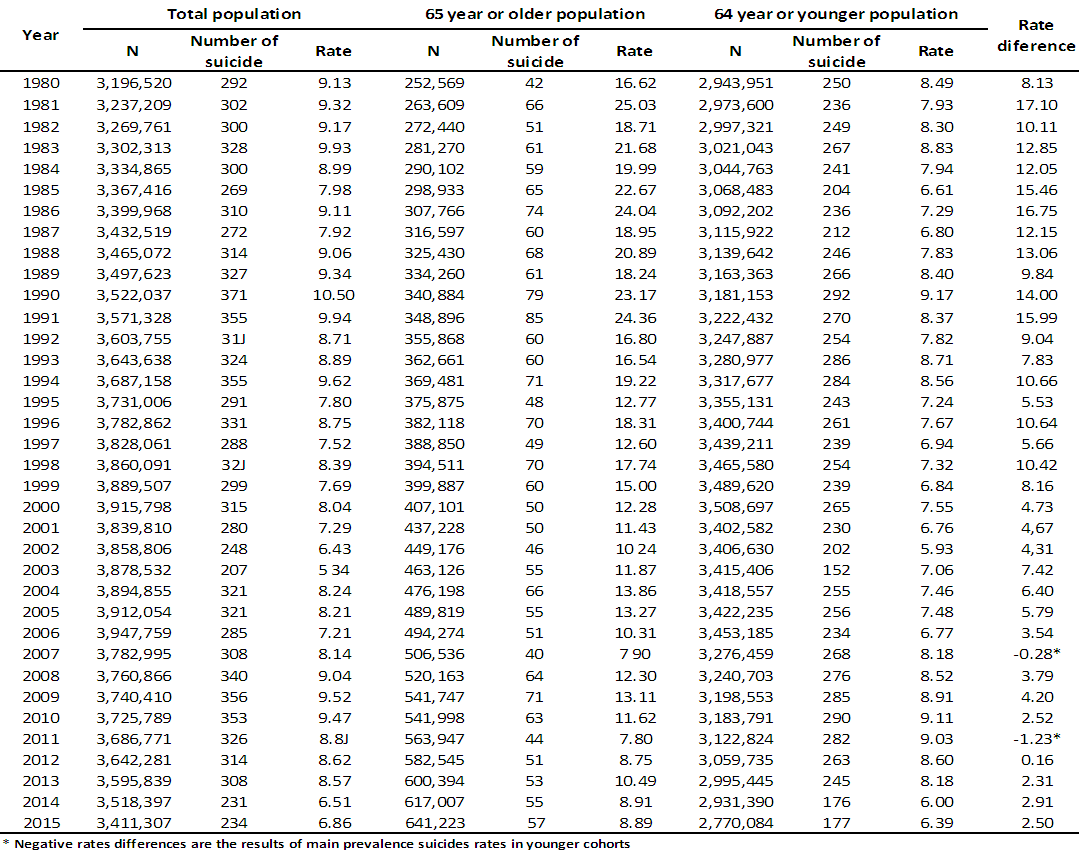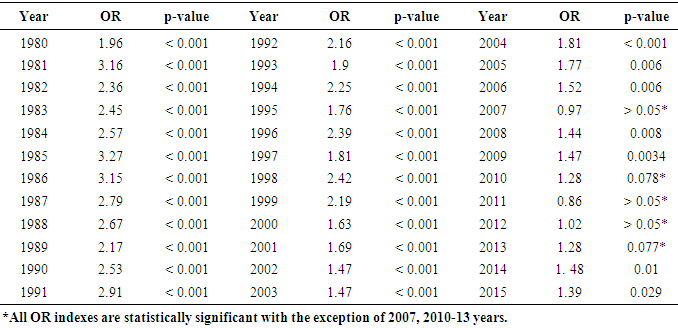-
Paper Information
- Paper Submission
-
Journal Information
- About This Journal
- Editorial Board
- Current Issue
- Archive
- Author Guidelines
- Contact Us
Public Health Research
p-ISSN: 2167-7263 e-ISSN: 2167-7247
2017; 7(2): 46-48
doi:10.5923/j.phr.20170702.02

Puerto Rican Retrospective Elderly Suicide Prevalence Rates: An Epidemiological Study during the 1980-2015 Period
José Rodríguez Gómez 1, 2, Rosa Janet Rodríguez Benítez 1, Kathía Y. Rodríguez Pagán 3, Dharma Rodriguez Pagan 4
1University of Puerto Rico, College of Social Sciences, General Social Sciences Department, San Juan, PR
2Carlos Albizu University, Clinical Psychology Program, San Juan, PR
3University of Puerto Rico, College of Natural Sciences, Nutrition and Dietetics Department, San Juan, PR
4University of Puerto Rico, Graduate School of Public Health, Department of Demography, San Juan PR
Correspondence to: Rosa Janet Rodríguez Benítez , University of Puerto Rico, College of Social Sciences, General Social Sciences Department, San Juan, PR.
| Email: |  |
Copyright © 2017 Scientific & Academic Publishing. All Rights Reserved.
This work is licensed under the Creative Commons Attribution International License (CC BY).
http://creativecommons.org/licenses/by/4.0/

This retrospective epidemiology study presents the suicide prevalence rates in Puerto Rico (PR) during 1980-2015 period. The investigation present suicides comparisons rates between two groups, 65 years or older, and 64 years and younger, in addition to odds ratio (OR) and mean indexes. Results indicates substantial differences in the suicide prevalence rates among groups. It is concluded that the elderly population has had, in average, a double suicide risk (OR=2.15, non-significant OR’s indexes were excluded) than younger Puerto Rican population. Effective public policy to diminish suicide rates in PR, with emphasis in the elderly, was suggest.
Keywords: Puerto Rico Suicide rates, Elderly suicide, Epidemiology
Cite this paper: José Rodríguez Gómez , Rosa Janet Rodríguez Benítez , Kathía Y. Rodríguez Pagán , Dharma Rodriguez Pagan , Puerto Rican Retrospective Elderly Suicide Prevalence Rates: An Epidemiological Study during the 1980-2015 Period, Public Health Research, Vol. 7 No. 2, 2017, pp. 46-48. doi: 10.5923/j.phr.20170702.02.
1. Introduction
- During the last 35 years, elderly suicide has been a serious problem in the Caribbean island of Puerto Rico (PR). Early research demonstrates major prevalence rates of suicide in elderly persons (65 years and older) as compare to younger population suicide rates [1-3]. PR has been suffering from extremely adverse socio-economic and health conditions approximately during the last 40 years that negatively affected the entire population. For instance, increases in, crime rates, scholar desertion, unemployment rates, substantial professional younger adults’ migration to the United States, cases of severe contagious diseases that affect tourism (i.e., ZIKA and Dengue Haemorrhagic Fever), severe governmental debt that bring the island to bankruptcy and affect enormously all types of health services, has adverse influence the elderly mental and physical health. As demonstrated by gerontological researcher’s this population suffer from many serious physical and mental health conditions that affect prominently their wellbeing including elderly margination and abuse [4, 5]. Specific factors that affect the Puerto Rican elderly population include, but are not limited to, high poverty levels, health disparities, mental and physical higher prevalence’s rates diseases (i.e., diabetes, cancer, cardiovascular conditions) and social margination. With all these issues, is not surprising that Puerto Rican elderly may be at elevated risk to suicide, as compare to other subpopulations in the island of PR.
2. Methodology
- Public Health Data from the Health Department of Puerto Rico from 1980 to 2015 was identify to determine the numbers of suicides during the previous period. Age groups where stratify in two main groups (10- 64 years old and 65 or older) to proceeded with the rates mortality analyses according to the interest of the researchers and the report of suicide rates of the Puerto Rico Health Department Statistics. Odds ratios (OR) were also calculated to determine the risk probability of suicide in the two groups. OR is a risk analysis of specific factors that impinge in the elderly suicide rates. Odds ratio have turn out to be increasingly important in health, specific in epidemiological research and decision-making. The OR evaluates whether the odds of a specific incident is the same for two groups. Specifically, the OR measures the ratio of the odds that an incident or outcome will occur to the odds of the event not happening. Usually, the researcher measures the ratio of the odds of a disease or a death from a specific injury, illness or phenomenon, happening to the odds of the death not occurring [6]. After calculations of mortality rates and OD’s ratios between both age groups comparison within them where performed.
3. Results
- After analyzed the mortality rates of both age groups, in addition to compared OR mean within the groups, we found that the older group (65 or older) continue to present the highest suicide prevalence rate (See Table 1). Furthermore, mean OR index is 2.15, meaning the elderly group have twice the probability to attain suicide than the younger group (See Table 2). In addition, mean suicide rate for the whole island of PR during the last 35 years is 152.99 as compare to the elderly mean suicide rate population (65 or older) that is 59.17.
 | Table 1. Suicide prevalence rates in Puerto Rico: 1980-2015 |
 | Table 2. OR’s indexes between 0-64 years and 65 or older |
4. Conclusions
- Puerto Rican elderly population has double the risk of suicide in the last 35 years. Currently precarious socio-economic conditions of PR make the elderly population at a higher risk than other subjects due do fragile conditions they experienced. It is expected that this phenomenon will not change in a near future unless interventional programs to prevent suicide be activated and effectively promoted [7]. It is imperative to foment sensitive crisis prevention programs and public policies in Puerto Rico with emphasis in the elderly population. Governmental and private agencies efforts need to put together strategies to prevent suicides in PR.
 Abstract
Abstract Reference
Reference Full-Text PDF
Full-Text PDF Full-text HTML
Full-text HTML